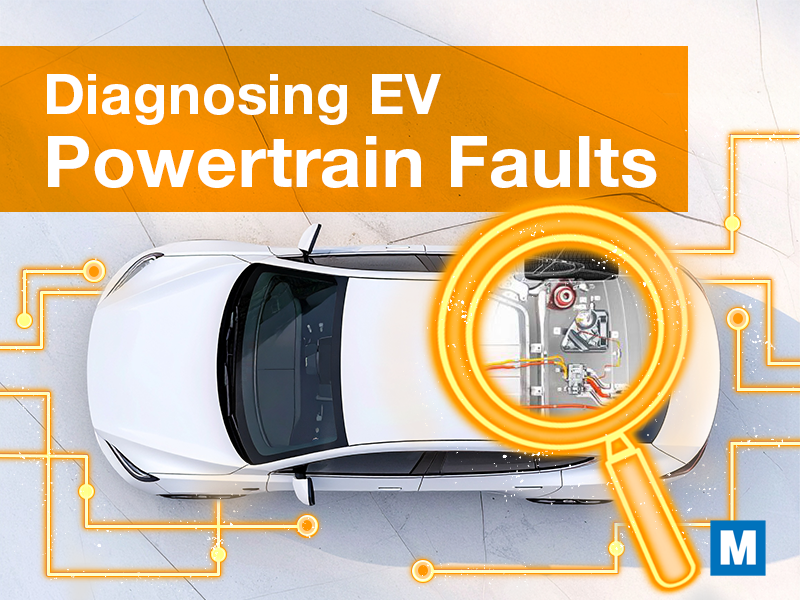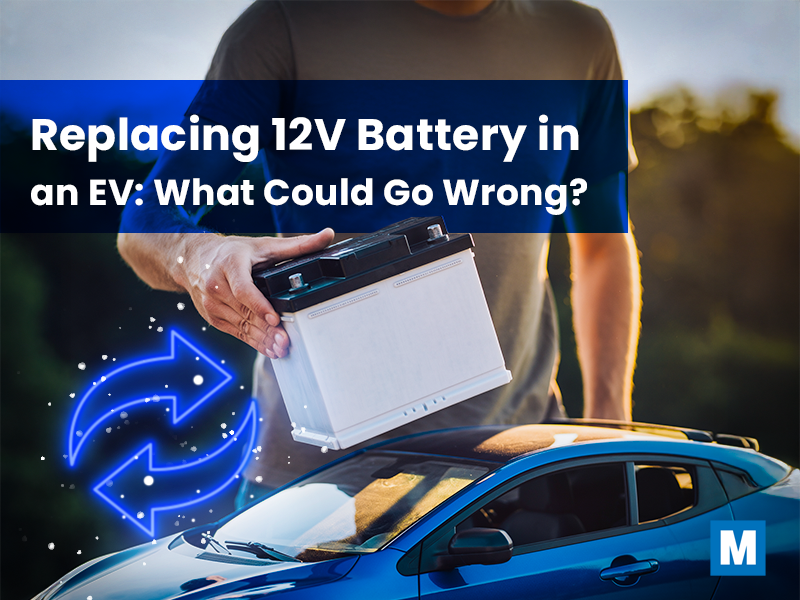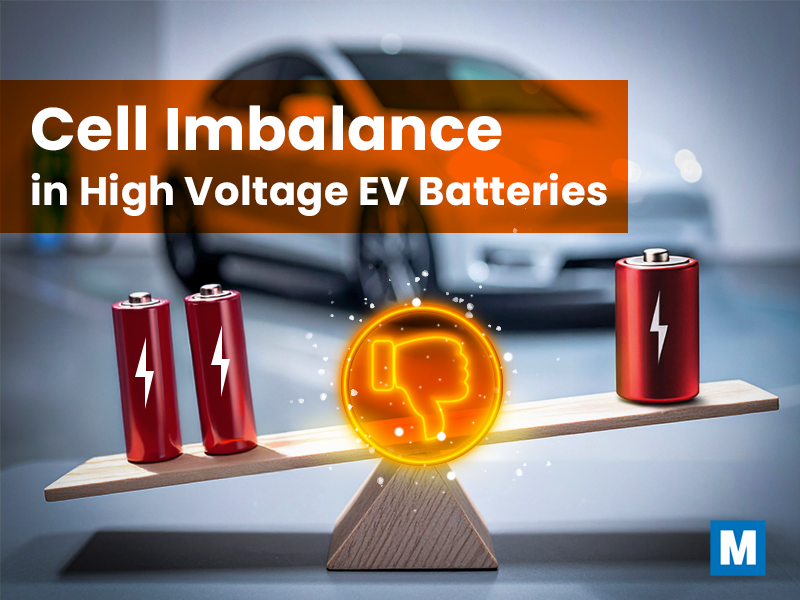When an internal combustion engine car has trouble starting or moving, most techs know where to begin: battery, starter, fuel delivery, ignition. But EVs are a different game. With fewer mechanical parts and more sophisticated electronics, powertrain issues can sometimes mask as battery problems when the real fault lies deeper.
If your shop is seeing more electric vehicles come through the service lane, it’s time to build confidence in EV powertrain diagnostics. Not every power or drivability issue is caused by a failing high-voltage battery. In fact, misdiagnosing the problem can lead to unnecessary battery replacement, customer dissatisfaction, and wasted time.
The EV Powertrain: A Quick Overview
In a typical EV, the powertrain includes:
- High-voltage (HV) battery pack
- Battery management system (BMS)
- Inverter/converter assembly
- Electric motors
- Transmission or reduction gear
- High-voltage wiring and connectors
Power is stored in the HV battery, converted by the inverter to AC or DC depending on motor type, and sent to the motor to move the wheels. All of this is controlled by onboard software and a network of sensors monitoring performance, temperature, voltage, and current at every stage.
So, when the vehicle won’t move or throws a warning light, the culprit could be almost anywhere in that chain.
Symptom: “Reduced Power” or “Limp Mode”
When a customer reports that their EV suddenly has reduced power, shorter range, or sluggish acceleration, it’s tempting to blame the battery. But in many cases, the vehicle has entered a protective mode triggered by another system fault.
Things you may need to investigate include:
- Inverter– Overheating in the inverter can cause the system to derate power output.
- Motor – Issues with the motor itself can reduce torque output.
- High-voltage cable – Increased resistance due to corrosion or loose connections can limit current delivery.
- BMS – A bad sensor in the battery pack might report incorrect voltage or temperature, triggering the behavior.
Use a scan tool or diagnostic platform like Midtronics’ GRX-5100 to check for inverter, motor, and BMS statuses. Don’t just scan the battery – scan the whole powertrain.
Symptom: EV Won’t Start or Won’t Charge
This is a common one: the customer plugs in their EV and either gets no response, or the car won’t go into drive. They assume the battery’s dead, but it’s often not that simple.
Common non-battery culprits are:
- Contactors – These high-voltage relays connect the battery to the rest of the system. If they stick open or fail to close, the vehicle may act as if the battery isn’t supplying power.
- Charge port or onboard charger faults – A bad connection, damaged port, or software glitch can interrupt charging entirely.
- 12V battery – Ironically, many EVs rely on a traditional 12V battery to power up control modules. If that battery is weak or dead, the HV system may not initialize.
- Faulty interlocks – These safety switches confirm that high-voltage components are properly connected. If any are open or improperly aligned, the system may shut down.
To diagnose it, check the 12V system first. A bad auxiliary battery can stop the show. Then, test contactor response and voltage handoff and inspect the charge port for damage or water.
Symptom: Unexpected Shutting Down While Driving
This is a red-alert issue. If an EV shuts down on the road, customers are rightly startled. But again, the battery might not be the culprit.
Investigate:
- Inverter or motor thermal shutdowns
- BMS fault causing a system-wide power cut
- High Voltage Interlock Loop fault
- Crash or rollover sensor fault
The HVIL system is designed to open the high-voltage loop if any component is accessed or compromised. A faulty sensor, poor connector seating, or wire damage can trigger it erroneously, cutting power while driving.
To diagnose it, check for HVIL-related codes and physically inspect connectors and harnesses. You’ll also want to review freeze-frame data from the shutdown event.
Using Midtronics Tools to Speed Up Accurate Diagnosis
Trying to sort through these complex systems without the right diagnostic gear is like guessing in the dark. Midtronics’ EV-focused platforms are designed to work with high-voltage systems safely and efficiently.
For example, tools can:
- Read DTCs across multiple modules including BMS, inverter, and charger
- Display live data like current, voltage, cell balance, and temperature
- Perform insulation and resistance checks
- Confirm contactors work
Instead of guessing whether the battery is weak, you can test and rule it out in minutes, and then move on to what really needs attention.
Creating Value with High-Voltage System Diagnostics
Here’s the good news: diagnosing EV powertrain faults is a high-value service. When you can pinpoint a failed inverter, contactor, or thermal management fault without replacing the entire battery, you save the customer thousands and become their go-to service provider. You also reduce parts return rates, lower your own liability, and increase first-time fix rates.
Some dealerships and repair shops are already offering EV “Powertrain Health Check” services that include:
- HV battery testing
- Inverter system scan
- Motor insulation resistance test
- BMS status report
It’s a smart move that positions your shop as an EV destination while adding real revenue from diagnostics, not just repairs.
What to Watch For in the Shop
EVs bring some new workflow challenges, and you’ll likely have to address them all at some point. For example, only trained and certified techs should work on HV systems for obvious safety reasons.
Also, some modules like inverters and cables can require disassembly to inspect. Plus, OEMs are still refining EV systems, so check TSBs for known faults or software fixes.
Make sure your team stays current on training and that you have the proper PPE and insulated tools available for work on these high-voltage systems.
Conclusion: It’s Not Always the Battery
It’s easy to blame the battery when something goes wrong in an EV. But with today’s complex powertrain systems, that’s often just the starting point. Regardless what’s actually at fault, accurate diagnostics are the key to cost-effective, safe, and satisfying service.
With the right tools, the right training, and a systematic approach, your shop can thrive in the EV transition.
When it comes to EV powertrain faults, be the shop that knows it’s not always the battery and prove it with every diagnosis. Let Midtronics help you diagnose confidently and keep EV customers coming back for the long haul, help you find new reasons for customers to return, and explore new ways to keep your service department thriving in the electric future.




